Quartier Général d'Aboville
| Quartier General d'Aboville | |
|---|---|
| Part of Armée de Terre | |
| Located near: Chaumont, Haute-Marne, France | |
|
Main Gate - 1962 | |
 Chaumont AB Location of Chaumont-Semoutiers Air Base, France | |
| Coordinates | 48°04′47″N 5°03′01″E / 48.07972°N 5.05028°ECoordinates: 48°04′47″N 5°03′01″E / 48.07972°N 5.05028°E |
| Site information | |
| Controlled by | Armée de Terre |
| Site history | |
| Built | 1951 |
| In use | 1952–Present |
| Garrison information | |
| Garrison | 61e Régiment d'artillerie (61e RA) Aerial Surveillance Regiment |
| Airfield information | |||||||||||
|---|---|---|---|---|---|---|---|---|---|---|---|
| IATA: XCW – ICAO: LFJA | |||||||||||
| Summary | |||||||||||
| Elevation AMSL | 1,018 ft / 310 m | ||||||||||
| Runways | |||||||||||
| |||||||||||
Quartier Général d'Aboville, formerly Chaumont-Semoutiers Air Base, is a French Army artillery base in France. It is located two miles (3 km) southwest of the city of Chaumont, Haute-Marne, just to the west of the Route Nationale 67 (N67) highway about 0.5 miles (1 km) north of Semoutiers-Montsaon in the Haute-Marne département of northeast France. During the early years of the Cold War, Chaumont-Semoutiers air base was used by United States Air Forces in Europe (USAFE).
Origins
The area around Chaumont has a long history of American military presence. During World War I the Haute-Marne département was one of the bloodiest areas of France with many battles fought on its soil. In 1917, the headquarters of the American Expeditionary Force was located in the city of Chaumont, Haute-Marne. Starting in the mid-1930s, a grass airstrip was used near Chaumont by the French Air Force for training. After the fall of France, the German Luftwaffe also used the facility as a training station. After the war, the airstrip was left unused.
With the outbreak of the Cold War in the late 1940s, with the Berlin Airlift and the ongoing threat from the Soviet Union to Western Europe, negotiations began in November 1950 between NATO and the United States to establish air bases and station combat wings in France to meet European defense needs.
During the negotiations for selection of sites, the World War II airfield at Chaumont was proposed for expansion into a modern air base. The airfield was unused since the war and there were no plans for French civil or military use. An agreement was reached to develop Chaumont into a NATO facility and station United States Air Force tactical fighter-bombers there by 1953.
United States Air Force tenure
Construction of Chaumont-Semoutiers Air Base started on 25 January 1951, with much effort being made to have minimal facilities ready by November. Various delays, however, pushed runway construction back to October.
The design of the airfield was to space parked aircraft as far apart as possible by the construction of a circular marguerite system of hardstands that could be revetted later with earth for added protection. Typically the marguerite consisted of fifteen to eighteen hardstands around a large central hangar. Each hardstand held one or two aircraft, and allowed the planes to be spaced approximately 150 feet (50 m) apart. Each squadron was assigned to a separate hangar/hardstand complex. This construction can be seen clearly in the satellite image link at the bottom of this article.
Minimum facilities were ready for USAF use by April 1952. The facilities consisted of 255 tent frames built on concrete floors, and 24 prefabricated wooden buildings with utilities. The entire facility was a work in progress, however, until 1956.
137th Fighter-Bomber Wing

In May 1952, the 137th Fighter-Bomber Wing activated at Chaumont with the 125th, 127th, and 128th Fighter Squadrons flying the Republic F-84G "Thunderjet".
The unit was part of the Oklahoma Air National Guard and was called to active duty on 10 October 1950 during the Korean War. When activated, the Wing flew various versions of the F-84, with the 125th FBSquadron flying F-84B's at Will Rogers Airport at Tulsa; the 127th FBS flying F-84Cs at Wichita Municipal Airport in Kansas, and the 128th FBS at Dobbins Air Force Base near Atlanta, Georgia, flying P-47D's (redesignated F-47's).
By 27 November, the wing assembled Alexandria Municipal Airport Louisiana for conversion training in the newer F-84Gs. Deployment of the wing was delayed, however, by the need to transfer pilots to Korea from training and delays in receiving engines for the F-84Gs, as well as the ongoing construction at Chaumont. Training and delays continued throughout 1951. Due to these delays, most of the activated National Guard airmen were released from active duty and never deployed to France.
With mostly regular Air Force personnel and all the delays behind them, the Wing departed Louisiana on 5 May 1952 for Europe, however, the 137th inherited a base that was little more than acres of mud where wheat fields used to be. The only hardened facilities at Chaumont was a concrete runway and a handful of tarpaper shacks. For the first two years of residence at Chaumont, the wing headed up an engineering project that resulted in the construction of permanent barracks, a wing headquarters, flightline shops, and warehouses.
Runway and taxiway preparation, along with final negotiations with the French government to allow nuclear weapon capable F-84's on its soil prevented the aircraft from being deployed to Chaumont, with the 125th and 127th Fighter-Bomber Squadrons being stationed at Ramstein Air Base and the 128th being stationed at Neubiberg Air Base in West Germany until final approval was received. The aircraft arrived at Chaumont on 25 June, being the first USAF tactical air fighters to be based permanently in France, albeit working mostly in tents and temporary wooden buildings on their new base.
At Chaumont, the 137th flew 61 F-84G's, approximately 20 aircraft per squadron. In addition, there were two C-47s, a T-6F, and three T-33A support aircraft.
During the summer, pilots of the 137th deployed to Wheelus Air Base, Libya, to obtain air-to-air and air-to-ground bombing and gunnery proficiency.
48th Fighter-Bomber Wing
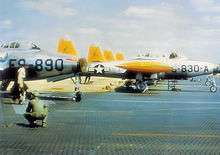
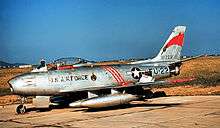
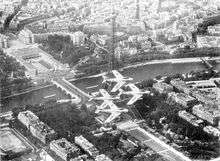
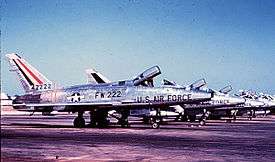
On 10 July 1952, the 48th Fighter-Bomber Wing activated and took over the mission from the 137 FBW. The 48th, with three fighter squadrons, the 492d, 493d, and 494th gained the personnel and equipment of the 137th. The 137 FBW was reassigned without personnel and equipment, back to the control of Oklahoma Air National Guard. The 58 F-84Gs and support aircraft were assigned to the 48th. The few National Guardsmen still with the wing departed and the last were released from active duty on 9 July, although a few reserve officers remained on active duty for an additional six to twelve months.
With the F-84, the 48 FBW supported NATO and the United States Air Forces in Europe (USAFE), activities, participating in exercises with the US Seventh Army. In addition, the 48th conducted operational readiness exercises and tactical evaluations. Honing bombing and gunnery skills. The 48th frequently deployed to Wheelus AFB, Libya for training.
The 48th developed into the premier fighter wing in France, serving the longest, from 10 July 1952 through 15 January 1960. The men and women of the 48th worked hard to develop Chaumont-Semoutiers Air Base into one of the best air bases in Europe. Its squadrons remained unchanged while flying three different type of fighters, the F-84G, F-86F and the F-100D, and maintaining the capability to fight either a conventional or nuclear war if need be.
An open house was held once a year, with great numbers of French civilians in attendance. In 1954, over 15,000 attended the Armed Forces Day event to see static aircraft displays, watch flight demonstrations, listen to a French army band and other activities. In just over three years since construction began, Chaumont Air Base became an important part of the Haute-Marne region.
To bolster Franco-American relations, the 48th Wing Staff came up with the idea of changing the wing insignia. Chaumont AB is located not far from the workshops of Frédéric Bartholdi—the French architect who designed the Statue of Liberty. The new design incorporated the Statue of Liberty, and throughout Europe the 48th became known as the "Statue of Liberty" Wing. On 4 July 1954 the mayor of the town of Chaumont bestowed the honorary title of the Statue de la Liberté (Statue of Liberty) Wing upon the 48th. It is the only USAF unit with both an official name and a numerical designation.
In addition, the town of Chaumont donated a 9-foot (2.7 m) bronze statue to the wing which was cast from an original Bartholdi mold built for creating a design model of the Statue of Liberty. The monument still exists today on Chaumont Air Base.
In November 1953, the wing exchanged its F-84Cs for newer F-86F "Sabre", receiving 75 aircraft, 25 per squadron. Then in late 1956 that the Air Force would exchange the 48th's Sabers for a newer aircraft: the F-100D "Super Sabre".
The larger-bodied F-100 was capable of carrying more ordnance than the F-86 and was one of the first fighters designed to operate at supersonic speeds. 90 single-seat F-100D aircraft were received, along with 13 F-100F dual-seaters.
The wing began realigning its units 15 March 1957, as part of an Air Force worldwide reorganization. Combat groups were inactivated, assigning the unit's fighter mission to the wing. As part of yet another organization change, the 48th dropped the "Fighter Bomber" designation 8 July 1958, becoming the 48th Tactical Fighter Wing. The three flying units also changed designation, becoming tactical fighter squadrons.
A change in residence, however, loomed on the horizon for the 48th. Disagreements arose concerning atomic storage and custody issues within NATO, resulting in a decision to remove Air Force atomic-capable units from French soil. Simultaneously, the advent of the inter-continental ballistic missile had reduced the United States’ dependence on European-based airborne medium- and long-range bombers.
On 15 January 1960, the 48 TFW redeployed to RAF Lakenheath, UK. In the early morning, the wing's three fighter squadrons lifted off Chaumont's runway and, after making farewell passes over the outlying village, headed toward the English Channel.
With the departure of the 48th, Chaumont-Semoutiers Air Base was placed in reserve status. The base became a satellite of Toul AB, being maintained by the 7544th Combat Support Group.
1961 Berlin Crisis
After almost two years without any permanent flying units, Chaumont Air Base was reactivated as part of Operation Tack Hammer, the United States response to the Berlin Crisis of 1961.
7108th Tactical Wing
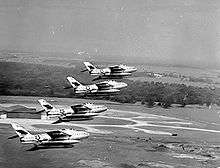
On 1 October 1961, as a result of the Berlin crisis, the New Jersey Air National Guard (ANG) 108th Tactical Fighter Wing was ordered to active duty. When activated, the 108th consisted of three squadrons, the 119th TF Squadron at Atlantic City Airport, the 141st TFSquadron at McGuire Air Force Base, New Jersey, and the 149th TF Squadron at Byrd Field, near Richmond, Virginia. All three squadrons were flying the F-84F Thunderstreak.
Only a portion of the 108th TFW deployed to France due to DOD budget limitations. This consisted of 28 F-84Fs of the 141st TFS and officers and airmen from all three squadrons, with the remaining aircraft and personnel remaining on active duty at their home stations. The first elements of the 108th deployed to Chaumont from McGuire AFB on 16 October with the last aircraft and personnel arriving on 6 November. The ground units deployed by sealift, with the deployed elements reaching Chaumont by 17 November.
In France, the deployed elements of the 108th TFW were designated the 7108th Tactical Wing on 20 November due to the reduced strength of the wing in Europe. The primary mission of the 7108th was to provide close air support to the Seventh Army in Europe under the direction of Ground Forward Air Controllers. To accomplish this mission, up to 30 sorties were flown each day. Pilots and aircraft were rotated back and forth from Atlantic City and Richmond in order for all pilots in the wing to become familiar with flying conditions at Chaumont and to teach USAFE operational procedures.
106th Tactical Reconnaissance Squadron
The 106th Tactical Reconnaissance Squadron from the 7117th Tactical Wing at Dreux-Louvillier Air Base spent all its time in France flying from Chaumont. The 7117th was another Air National Guard wing called to active duty during the Berlin Crisis, but was prohibited from flying its RF-84s from Dreux due to flight restrictions in the Orly Airport area. The 106th remained and operated from Chaumont until its inactivation and departure for CONUS in July 1962.
In April 1962 as the Berlin Crisis subsided, plans were being made to return the activated squadrons to the United States. On 7 June, the 7108th TW received orders directing the wing to return to CONUS with all personnel, but leaving the 24 F-84s in place at Chaumont. In addition, the deployed personnel would assist in the smooth transition of the base to the newly activated 366th Tactical Fighter Wing to be permanently based at Chaumont after their departure.
The 7108th departed from Chaumont and was relieved from active duty in August 1962. All personnel were released from active duty and returned to Air National Guard status.
366th Tactical Fighter Wing
On 30 April 1962, the 366th Tactical Fighter Wing was activated and assigned to USAFE. It had four Tactical Fighter Squadrons, formed by absorbing the assets and personnel of the Air National Guard squadrons rushed to Europe in the wake of the Berlin Crisis, then as the ANG personnel were demobilized, personnel were drawn from the active-duty ranks. On 8 May 1962 it was reassigned to Seventeenth Air Force. Each squadron flew 20 former ANG F-84Fs.
With Wing Headquarters at Chaumont, the 366th TFW was organized as follows:
- 389th Tactical Fighter Squadron (Chaumont AB Blue striping)
- 390th Tactical Fighter Squadron (Chambley AB Yellow striping)
- 391st Tactical Fighter Squadron (Etain AB Red striping)
- 480th Tactical Fighter Squadron (Phalsbourg AB Green striping)
The 480th TFS operated at Chaumont until runway repairs were completed at Phalsbourg then deployed there on 20 December. This multi-base organizational structure was unique in that it was the only tactical fighter wing in USAFE with four squadrons at four different air bases in Europe. The 366th was also the last USAFE tactical fighter wing formed in Europe. In addition to the flying units being dispersed, the 366th also formed Combat Support Groups at each base to support the flying operations.
The decision to form, organize, equip and train the 366th at four different bases was a poor decision by USAFE. The first major problem being the simple logistics needed to operate the squadrons. Deliveries of services in France had always been a problem since the USAF bases were established in the early 1950s. Delivery of supplies and equipment sometimes took months, not weeks. In addition, the F-84G was being phased out of the USAF since 1958 and there was a shortage of pilots and trained mechanics in USAFE for the model. Personnel issues such as married personnel avoiding assignments in France due to poor housing conditions meant that most assigned personnel were first-term airmen with little, or elementary job skills. Also, the cost of maintaining USAFE bases in France were significantly higher.
Transition to the newer F-84F began in the fall of 1962, however in the middle of the pilot upgrade training, the 366th was needed to respond to the Cuban Missile Crisis, assuming a 24/7 alert posture for two weeks beginning on 23 October. Some deployed aircraft were called back from Wheelus Air Base Libya where they were undergoing training. Targets in Eastern Europe were identified and changed on a daily, sometimes hourly schedule. Two KB-50 tankers were flown into Chaumont to provide aerial refueling to the tactical aircraft if necessary. On 5 November, the 24/7 alert was stood down and operations returned to normal peacetime levels.
Unlike their Air National Guard predecessors, HQ USAFE did not provide the 366th with a definitive mission statement. The wing simply continued to build on the 7108th Tactical Wing's missions. These were expanded to include the capability to receive and support dual-based CONUS tactical fighter squadrons. Plans were made for the 366th to absorb up to four additional fighter squadrons and operate from three additional NATO Dispersed Operating Bases.
A result of French president Charles de Gaulle's deep suspicion of "supranational organizations" and France's shift away from the NATO orbit in the early 1960s ultimately led to the decision in November 1962 that Chambley, Chaumont, Etain and Phalsbourg air bases would be returned to reserve status.
On 26 April 1963, the 366 TFW was notified of its pending relocation to Holloman AFB, New Mexico. The initial deployment of personnel began on 4 June. Personnel and equipment were either moved to Holloman, or reassigned throughout USAFE. The 366th officially departed Chaumont on 22 July 1963.
USAF closure
After the departure of the 366 TFW, Chaumont was in a reserve status, being used occasionally for NATO exercises and deployments. A small USAF contingent group, the 7366th Combat Support Group operated at the base to maintain its facilities. On 7 March 1966, French President Charles de Gaulle announced that France would withdraw from NATO's integrated military structure. The United States was informed that it must remove its military forces from France by 1 April 1967.
By the end of 1966, all USAF equipment was removed from Chaumont, and on 26 March 1967 the last American assigned to Chaumont left the facility and the base was turned over to French control.
Current uses
After the USAF withdrawal from France in 1967, the French Army took up residence at Chaumont, changing its name to Quartier General d'Aboville. The 403e Régiment d'artillerie (403e RA) operated from the installation. Detachments of the Regiment participated in the 1991 Gulf War, the humanitarian intervention in Rwanda, peacekeeping operations in Lebanon and Bosnia and various internal security system operations of the 'Vigipirate' and 'Polmar' type. The Regiment was disbanded on the 30th June 1999.
In 1999, the French Army 61e Régiment d'artillerie (61e RA) Aerial Surveillance Regiment arrived at Chaumont equipped with the CL 289 drone.
The 61st Artillery regiment has deployed on NATO exercises to Bosnia and Kosovo.
In addition to the Army, the French militarised police Force (Gendarmerie Nationale) has also taken up residence at Chaumont-Semoutiers.
References
![]() This article incorporates public domain material from the Air Force Historical Research Agency website http://www.afhra.af.mil/.
This article incorporates public domain material from the Air Force Historical Research Agency website http://www.afhra.af.mil/.
- Endicott, Judy G. (1999) Active Air Force wings as of 1 October 1995; USAF active flying, space, and missile squadrons as of 1 October 1995. Maxwell AFB, Alabama: Office of Air Force History. CD-ROM.
- McAuliffe, Jerome J. (2005). US Air Force in France 1950-1967. San Diego, California: Milspec Press, 9, Chaumont-Semoutiers Air Base. ISBN 0-9770371-1-8.
- Ravenstein, Charles A. (1984). Air Force Combat Wings Lineage and Honors Histories 1947-1977. Maxwell AFB, Alabama: Office of Air Force History. ISBN 0-912799-12-9.
- USAAS-USAAC-USAAF-USAF Aircraft Serial Numbers 1908 to present
- Loubette, Fabrice (2008). Les forces aériennes de l'OTAN en Lorraine, 1952-1967. Metz, France : Serpenoise, Part II, Chapter 6, Chaumont Air Base. ISBN 978-2-87692-763-6.
External links
- 48th Fighter Wing RAF Lakenheath UK
- 108th Refueling Wing New Jersey ANG
- 61e régiment d'artillerie (in French)
- 48 FBW F-100 photos
- Airport information for LFJA at World Aero Data. Data current as of October 2006.
